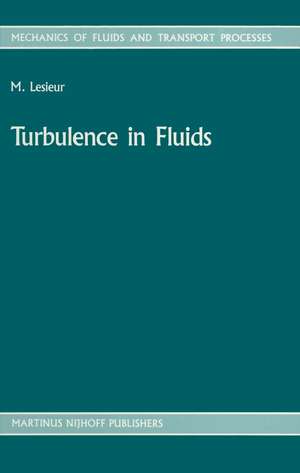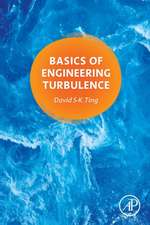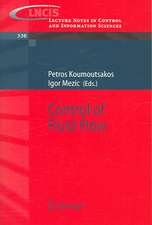Turbulence in Fluids: Stochastic and Numerical Modelling: Mechanics of Fluids and Transport Processes, cartea 6
Autor Marcel Lesieuren Limba Engleză Paperback – 28 iul 2012
| Toate formatele și edițiile | Preț | Express |
|---|---|---|
| Paperback (3) | 388.52 lei 6-8 săpt. | +40.83 lei 4-10 zile |
| SPRINGER NETHERLANDS – 20 sep 2014 | 443.31 lei 17-23 zile | +40.83 lei 4-10 zile |
| SPRINGER NETHERLANDS – 28 iul 2012 | 388.52 lei 6-8 săpt. | |
| SPRINGER NETHERLANDS – 21 oct 2011 | 647.73 lei 6-8 săpt. | |
| Hardback (1) | 553.50 lei 6-8 săpt. | |
| SPRINGER NETHERLANDS – 18 dec 2007 | 553.50 lei 6-8 săpt. |
Preț: 388.52 lei
Nou
Puncte Express: 583
Preț estimativ în valută:
74.34€ • 77.82$ • 61.88£
74.34€ • 77.82$ • 61.88£
Carte tipărită la comandă
Livrare economică 01-15 aprilie
Preluare comenzi: 021 569.72.76
Specificații
ISBN-13: 9789401080859
ISBN-10: 9401080852
Pagini: 304
Ilustrații: 298 p. 15 illus., 4 illus. in color.
Dimensiuni: 155 x 235 x 16 mm
Greutate: 0.43 kg
Ediția:Softcover reprint of the original 1st ed. 1987
Editura: SPRINGER NETHERLANDS
Colecția Springer
Seria Mechanics of Fluids and Transport Processes
Locul publicării:Dordrecht, Netherlands
ISBN-10: 9401080852
Pagini: 304
Ilustrații: 298 p. 15 illus., 4 illus. in color.
Dimensiuni: 155 x 235 x 16 mm
Greutate: 0.43 kg
Ediția:Softcover reprint of the original 1st ed. 1987
Editura: SPRINGER NETHERLANDS
Colecția Springer
Seria Mechanics of Fluids and Transport Processes
Locul publicării:Dordrecht, Netherlands
Public țintă
ResearchCuprins
I Introduction to turbulence in fluid mechanics.- 1 Is it possible to define turbulence?.- 2 Examples of turbulent flows.- 3 Fully developed turbulence.- 4 Fluid turbulence and “chaos”.- 5 “Deterministic” and statistical approaches.- 6 Why study isotropic turbulence?.- II Basic fluid dynamics.- 1 Eulerian notation and Lagrangian derivatives.- 2 The continuity equation.- 3 The conservation of momentum.- 4 The thermodynamic equation.- 5 The incompressibility assumption.- 6 The dynamics of vorticity.- 7 The generalized Kelvin theorem.- 8 The Boussinesq equations.- 9 Internal inertial-gravity waves.- 10 Barré de Saint-Venant equations.- III Transition to turbulence.- 1 The Reynolds number.- 2 The Rayleigh number.- 3 The Rossby number.- 4 The Froude Number.- 5 Turbulence, order and chaos.- IV The Fourier space.- 1 Fourier representation of a flow.- 2 Navier-Stokes equations in Fourier space.- 3 Boussinesq equations in the Fourier space.- 4 Craya decomposition.- 5 Complex helical waves decomposition.- V Kinematics of homogeneous turbulence.- 1 Utilization of random functions.- 2 Moments of the velocity field, homogeneity and stationarity.- 3 Isotropy.- 4 The spectral tensor of an isotropic turbulence.- 5 Energy, helicity, enstrophy and scalar spectra.- 6 Alternative expressions of the spectral tensor.- 7 Axisymmetric turbulence.- VI Phenomenological theories.- 1 The closure problem of turbulence.- 2 Karman-Howarth equations in Fourier space.- 3 Transfer and Flux.- 4 The Kolmogorov theory.- 5 The Richardson law.- 6 Characteristic scales of turbulence.- 7 The skewness factor.- 8 The internal intermittency.- VII Analytical theories and stochastic models.- 1 Introduction.- 2 The Quasi-Normal approximation.- 3 The Eddy-Damped Quasi-Normal type theories.- 4 The stochasticmodels.- 5 Phenomenology of the closures.- 6 Numerical resolution of the closure equations.- 7 The enstrophy divergence and energy catastrophe.- 8 The Burgers-M.R.C.M. model.- 9 Isotropic helical turbulence.- 10 The decay of kinetic energy.- 11 E.D.Q.N.M. and R.N.G. techniques.- VIII Diffusion of passive scalars.- 1 Introduction.- 2 Phenomenology of the homogeneous passive scalar diffusion.- 3 The E.D.Q.N.M. isotropic passive scalar.- 4 The decay of temperature fluctuations.- 5 Lagrangian particle pair dispersion.- IX Two-dimensional and quasi-geostrophic turbulence.- 1 Introduction.- 2 The quasi-geostrophic theory.- 3 Two-dimensional isotropic turbulence.- 4 Diffusion of a passive scalar.- 5 Geostrophic turbulence.- X Absolute equilibrium ensembles.- 1 Truncated Euler Equations.- 2 Liouville’s theorem in the phase space.- 3 The application to two-dimensional turbulence.- 4 Two-dimensional turbulence over topography.- XI The statistical predictability theory.- 1 Introduction.- 2 The E.D.Q.N.M. predictability equations.- 3 Predictability of three dimensional turbulence.- 4 Predictability of two-dimensional turbulence.- XII Large-eddy simulations.- 1 The direct numerical simulation of turbulence.- 2 The Large Eddy Simulations.- 3 L.E.S. of 3-D isotropic turbulence.- 4 L.E.S. of two-dimensional turbulence.- XIII Towards “real world turbulence”.- 1 Introduction.- 2 Stably Stratified Turbulence.- 3 The Mixing Layer.- 4 Conclusion.- References.
Recenzii
`Turbulence in Fluids will serve as a graduate-text to follow up... '
Pageoph
`The book that Professor Lesieur has written on turbulence is an irreplaceable subject. Lesieur's work mixes rigor and intuition. ... it is the spirit in which it is written that is striking. Moreover the book is attractively presented. At the present time is seems difficult to ignore this book which fits very well into the collection of classical works on the subject.'
Prof. J. Mathieu, Laboratoire de Mécanique des Fluides et d'Acoustique
`The book is attractively produced ... some beautiful photographs ... this is an interesting and attractive book. Everyone interested in the more theoretical aspects of turbulence will want to read it. '
D.C. Leslie in Journal of Fluid Mechanics, 194
` .. a useful text for a first course in turbulence for physicists, or as a second course for engineering students who have already had a more phenomenological introduction to the subject. It is a useful reference for the specialist who may not keep at his fingertips some of the details of the analytical theories and stochastic models. '
AIAA Journal, 26:10
Pageoph
`The book that Professor Lesieur has written on turbulence is an irreplaceable subject. Lesieur's work mixes rigor and intuition. ... it is the spirit in which it is written that is striking. Moreover the book is attractively presented. At the present time is seems difficult to ignore this book which fits very well into the collection of classical works on the subject.'
Prof. J. Mathieu, Laboratoire de Mécanique des Fluides et d'Acoustique
`The book is attractively produced ... some beautiful photographs ... this is an interesting and attractive book. Everyone interested in the more theoretical aspects of turbulence will want to read it. '
D.C. Leslie in Journal of Fluid Mechanics, 194
` .. a useful text for a first course in turbulence for physicists, or as a second course for engineering students who have already had a more phenomenological introduction to the subject. It is a useful reference for the specialist who may not keep at his fingertips some of the details of the analytical theories and stochastic models. '
AIAA Journal, 26:10
Textul de pe ultima copertă
This is the 4th edition of a book originally published by Kluwer Academic Publishers. It is an exhaustive monograph on turbulence in fluids in its theoretical and applied aspects, with many advanced developments using mathematical spectral methods (two-point closures like the EDQNM theory), direct-numerical simulations, and large-eddy simulations.
The book is still of great actuality on a topic of the utmost importance for engineering and environmental applications, and presents a very detailed presentation of the field. The fourth edition incorporates new results coming from research work done since 1997. Many of these results come from direct and large-eddy simulations methods, which have provided significant advances in problems such as turbulent mixing or thermal exchanges (with and without gravity effects).
Topics dealt with include: an introduction to turbulence in fluid mechanics; basic fluid dynamics; transition to turbulence; shear-flow turbulence; Fourier analysis for homogeneous turbulence; isotropic turbulence; phenomenology and simulations; analytical theories and stochastic models; two-dimensional turbulence; geostrophic turbulence; absolute-equilibrium ensembles; the statistical predictability theory; large-eddy simulations; and a section that explores developments towards real-world turbulence.
The book is still of great actuality on a topic of the utmost importance for engineering and environmental applications, and presents a very detailed presentation of the field. The fourth edition incorporates new results coming from research work done since 1997. Many of these results come from direct and large-eddy simulations methods, which have provided significant advances in problems such as turbulent mixing or thermal exchanges (with and without gravity effects).
Topics dealt with include: an introduction to turbulence in fluid mechanics; basic fluid dynamics; transition to turbulence; shear-flow turbulence; Fourier analysis for homogeneous turbulence; isotropic turbulence; phenomenology and simulations; analytical theories and stochastic models; two-dimensional turbulence; geostrophic turbulence; absolute-equilibrium ensembles; the statistical predictability theory; large-eddy simulations; and a section that explores developments towards real-world turbulence.
Caracteristici
A complete introduction of fluid mechanics necessary to deal with incompressible and compressible turbulence A clear synthesis of turbulence and coherent-vortex dynamics in a wide range of shear flows A detailed presentation of spectral closures applied to velocity and scalar mixing in turbulence Details on advanced subgrid models for large-eddy simulations Numerous applications to industrial and environmental problems























